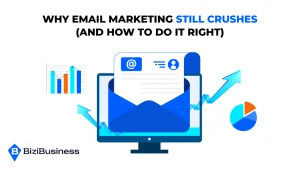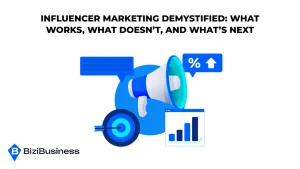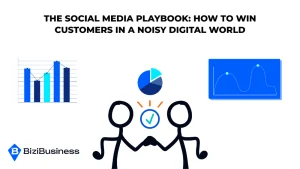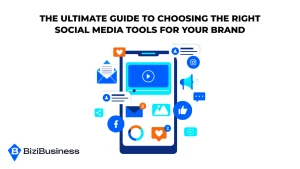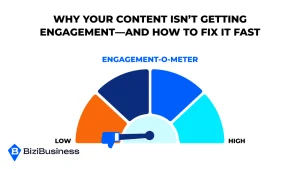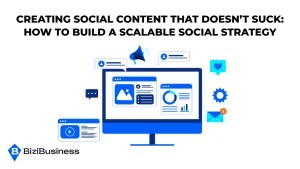BiziTopics
eCommerce SEO Mastery: The Only Guide You Need to Rank, Convert, and Scale
BiziBusiness
Jul 8, 2025
26 min read
Imagine this: A customer searches for a product you sell. Do they find your store—or your competitor’s?
In the world of eCommerce, SEO isn’t just another marketing tactic—it’s the foundation of sustainable, high-converting traffic. Unlike paid ads that require constant spending, SEO works for you 24/7, bringing in shoppers who are already searching for what you offer.
If you’re tired of burning cash on ads or fighting to get noticed in an oversaturated market, it’s time to harness the power of SEO.
Understanding eCommerce SEO: The Key to Sustainable Growth
If you want consistent, high-quality traffic that doesn’t rely on paid ads, eCommerce SEO is the answer. It’s what separates the stores that struggle for visibility from those that dominate search results and drive sales on autopilot.
But what exactly is eCommerce SEO? How does it differ from other types of SEO? And why is it one of the most profitable investments you can make for your online store? Let’s break it down.
What is eCommerce SEO?
eCommerce SEO is the process of optimizing your online store to rank higher on search engines (Google, Bing, etc.), so potential customers find your products when they search.
Think about it: When someone searches for a product you sell—“best wireless headphones” or “organic skincare products”—you want your store to show up on page one of Google.
✅ More visibility = More clicks
✅ More clicks = More customers
✅ More customers = More sales
Unlike traditional SEO (which focuses on blogs or informational content), eCommerce SEO is built around products, categories, and purchase intent. The goal? To make sure your product pages appear when people are ready to buy.
How eCommerce SEO Differs from Other SEO Strategies
SEO isn’t one-size-fits-all. The strategy for an eCommerce store is very different from optimizing a blog or corporate website.
Here’s how eCommerce SEO stands out:
| Aspect | eCommerce SEO | Traditional SEO (Blogs, Corporate Sites) |
|---|---|---|
| Main Focus | Ranking product & category pages | Ranking informational blog posts |
| User Intent | Primarily transactional (people ready to buy) | Mostly informational (people researching) |
| Key Elements | Product pages, category pages, structured data | Blog content, backlinks, keyword rankings |
| SEO Challenge | Duplicate content, faceted navigation issues | Long-form content creation & backlinking |
| Success Metric | Conversions & sales from organic traffic | Website traffic & lead generation |
The biggest difference? eCommerce SEO isn’t just about ranking high—it’s about ranking for the right keywords that drive actual sales.
A blog post ranking for “best running shoes” might get traffic, but a product page ranking for “buy Nike Pegasus 40 online” will convert at a much higher rate.
The Key Benefits of eCommerce SEO
So, why should you invest in SEO when paid ads can get you instant traffic?
Because SEO delivers higher ROI, long-term growth, and lower acquisition costs. Here’s why:
1. Free, High-Intent Traffic (Without Ongoing Ad Spend)
Paid ads disappear the moment you stop spending. SEO keeps driving traffic for free—even while you sleep.
2. Higher Conversion Rates Than Any Other Traffic Source
Traffic is worthless if it doesn’t convert. SEO brings in visitors who are actively searching for your products—meaning they’re already warmer leads compared to social media or display ads.
3. Reduces Your Dependence on Paid Ads (And Rising CPC Costs)
Paid ad costs (CPC) are rising every year. If your business relies solely on ads, you’re at the mercy of platform changes, higher competition, and increasing costs.
✅ SEO reduces customer acquisition costs over time.
✅ SEO compounds over time, meaning traffic grows even if you stop spending.
✅ SEO protects your brand from fluctuating ad costs.
4. Builds Brand Trust & Authority
Ranking on page one of Google = instant credibility. Customers are more likely to trust organic search results than paid ads.
5. Long-Term Growth with a Competitive Advantage
SEO isn’t a quick fix—but once your store ranks, it becomes a long-term traffic machine.
✅ You build a defensible traffic source that competitors can’t easily replicate.
✅ You get consistent, qualified traffic—even without running ads.
✅ You create a sustainable marketing channel that doesn’t rely on constant spending.
Keyword Research for eCommerce SEO

Keyword research is the foundation of successful eCommerce SEO. If you target the wrong keywords, you’ll struggle to get traffic—or worse, attract visitors who don’t convert.
In this section, you’ll learn how to find high-converting keywords, differentiate between keyword types, use the best research tools, and analyze your competitors to steal their traffic.
How to Find High-Converting Keywords for Your Products
Not all keywords are created equal. The best eCommerce keywords attract visitors who are ready to buy.
To find the right keywords, ask yourself:
✅ What would my ideal customer search for?
✅ What specific terms describe my product?
✅ How do competitors rank for similar products?
Where to Look for eCommerce Keywords:
- Google Auto-Suggest & Related Searches – Start typing a keyword and see what Google suggests. These are real searches from real customers.
- Amazon & eCommerce Marketplaces – Customers use Amazon like a search engine. Check product titles and descriptions for trending keywords.
- Customer Reviews & FAQs – Look at how customers describe your products in reviews. They often use terms that other shoppers search for.
Example: If you sell skincare products, instead of just targeting “moisturizer”, look for variations like “best moisturizer for dry skin”, “oil-free face moisturizer”, or “anti-aging moisturizer with SPF”—phrases with higher buying intent.
Short-Tail vs. Long-Tail Keywords: Which Ones Matter Most?
Understanding keyword length is key to picking the right strategy.
| Keyword Type | Example | Competition | Search Volume | Conversion Rate |
|---|---|---|---|---|
| Short-Tail Keywords | “Sneakers” | Very High | High | Low |
| Mid-Tail Keywords | “Men’s running sneakers” | Moderate | Medium | Medium |
| Long-Tail Keywords | “Best men’s running sneakers for flat feet” | Low | Low | Very High |
- Short-tail keywords (1-2 words) – Broad, high search volume, but low conversion rates because intent is unclear.
- Long-tail keywords (4+ words) – Lower search volume, but higher conversion rates because they match specific buyer intent.
What to Focus On? Long-tail keywords = easier rankings & more qualified traffic.
Using Keyword Research Tools: Find the Best Keywords for Your Store

Instead of guessing, use keyword research tools to find high-traffic, low-competition keywords that drive real sales.
Best Tools for eCommerce Keyword Research
- Google Keyword Planner (Free) – Find search volume, trends, and competition levels.
- Ahrefs / Semrush (Paid) – Spy on competitors and find untapped keyword opportunities.
- Ubersuggest (Freemium) – Great for long-tail keyword suggestions.
- KeywordTool.io – Pulls keyword data from Google, Amazon, YouTube, and more.
How to Use These Tools:
- Enter a broad keyword related to your product.
- Look for long-tail keywords with high commercial intent.
- Check search volume (too low = no traffic, too high = too competitive).
- Identify low-competition opportunities where you can rank faster.
Optimizing for Buyer Intent: Transactional vs. Informational Keywords
Not all keywords are equal in intent. Some people are looking for information, while others are ready to buy.
| Keyword Type | Example | Intent | Best For |
|---|---|---|---|
| Informational Keywords | “How to choose the best moisturizer” | Researching | Blog posts, guides |
| Transactional Keywords | “Buy anti-aging moisturizer online” | Ready to buy | Product pages |
- Informational keywords – People looking for advice, comparisons, and product recommendations. Use these in blog posts, guides, and FAQ sections.
- Transactional keywords – People searching with purchase intent. These belong on product and category pages to drive direct sales.
Best Strategy? Use informational keywords to attract traffic → then guide visitors to transactional keywords to close the sale.
Competitor Keyword Analysis: Stealing Their Traffic the Smart Way
If your competitors are ranking for profitable keywords, why not use that to your advantage?
How to Spy on Competitor Keywords:
- Find Your Top Competitors – Search for your product on Google. The top-ranking stores are your main competition.
- Use Ahrefs / Semrush / Ubersuggest – Enter their domain and see what keywords they rank for.
- Look for Weak Spots – Find high-volume keywords where competitors rank, but aren’t fully optimized
- Target Their Best Keywords – If a competitor ranks for “best vegan leather handbags”, optimize your product page for that exact keyword and beat them with better content & SEO.
On-Page SEO for eCommerce
If your store’s pages aren’t optimized, Google won’t rank them—and customers won’t find them.
On-page SEO is the art of making each page on your site search engine-friendly and conversion-focused. It’s where keyword strategy meets customer experience, and when done right, it turns browsers into buyers.
Here’s how to turn every product, category, and content page into a traffic magnet that converts.
Title Tags & Meta Descriptions: Your First Impression in Search
Before a shopper even clicks, your title tag and meta description are doing the heavy lifting. This is your mini ad on the search results page.
- Title Tag Best Practices:
- Include your target keyword near the front.
- Keep it under 60 characters to avoid truncation.
- Add compelling language that entices clicks (e.g., “Free Shipping”, “2024 Collection”).
- Meta Description Best Practices:
- Summarize the page in 155–160 characters.
- Use a clear benefit or unique selling point.
- Include a secondary keyword if possible.
Pro Tip: Write for the user first, search engine second. Your goal isn’t just to rank—it’s to get the click.
Product Page Optimization: Where SEO Meets Conversions
Your product pages aren’t just for Google—they’re for shoppers ready to buy. Let’s optimize them for both.
- Keyword-Rich Product Titles
- Include the main keyword, but keep it clear and natural.
- Don’t keyword-stuff—Google and shoppers will both bounce.
- Product Descriptions That Rank and Sell
- Use your primary and secondary keywords naturally throughout.
- Answer common customer questions.
- Highlight benefits, not just features.
- Break up content with bullet points for readability.
✅ Instead of: “This cream is good for your skin.”
✅ Use: “Infused with retinol and hyaluronic acid, this anti-aging cream helps reduce fine lines, brighten dull skin, and deliver deep hydration—all without irritation.”
- Compelling CTAs That Convert: Guide the shopper toward action with urgency and clarity.
- “Add to Cart Now”
- “Only 3 Left – Order Today”
- “Free Shipping Over $50 – Shop Now”
Alt Text & Image Optimization
Google can’t “see” your images, but it can read them.
- Use descriptive, keyword-relevant file names (black-vegan-leather-tote.jpg)
- Add alt text that describes the product in plain English
- Compress images for fast page loads
Bonus: Optimized images also help you rank in Google Image Search—an overlooked source of traffic.
Category Page SEO: Why It Matters More Than You Think
Most eCommerce sites focus on product pages—and totally neglect their category pages.
Big mistake.
Category pages often have the most SEO potential because they target broader, high-volume keywords and group related products together.
Optimize Your Category Pages With:
- A short, keyword-rich intro paragraph above the product grid
- Internal links to featured products or subcategories
- Optimized H1 and subheadings
- Unique content (don’t just copy product descriptions)
✅ Example: Your “Men’s Sneakers” page could rank for keywords like:
- “best men’s sneakers 2024”
- “lightweight running shoes for men”
- “men’s athletic footwear”
Pro Tip: Use filters and faceted navigation carefully—improper use can lead to duplicate content issues. Use canonical tags where needed.
Internal Linking: Build an SEO-Strong Site Structure
Internal links guide users (and Google) through your site—and they’re one of the easiest SEO wins.
- Best Practices for Internal Linking in eCommerce:
- Link from blog posts to product/category pages (e.g., “Check out our bestselling retinol cream”)
- Link between related products (“Pair it with this Vitamin C serum”)
- Use keyword-rich anchor text (not just “click here”)
- Create collections or “Best of” pages that link to high-priority products
Why it works:
✅ Helps Google discover and index more pages
✅ Passes SEO authority between pages
✅ Improves user experience and session time
Pro Tip: Use a simple, siloed structure:
Homepage → Category → Subcategory → Product
This keeps your SEO clean and navigable.
Technical SEO: The Foundation of a High-Ranking eCommerce Site

You can have the best product descriptions in the world, but if your store isn’t technically sound, Google won’t rank it—and customers won’t wait around to see it.
Technical SEO is the behind-the-scenes infrastructure that ensures your store is fast, crawlable, mobile-friendly, and easy for search engines to understand. Without it, all your on-page and content efforts won’t get the visibility they deserve.
Let’s break down the essential elements of technical SEO that every eCommerce site must master.
Site Speed & Core Web Vitals: Why Fast-Loading Pages Rank Higher
Product-heavy pages.
Multiple images.
Dozens of scripts.
eCommerce sites are often slower than they should be—and that’s a major problem.
Google’s Core Web Vitals are ranking factors. If your site is sluggish, not only will customers bounce, but your SEO will suffer.
- What to Optimize:
- Largest Contentful Paint (LCP): How quickly the main content loads. Target: under 2.5 seconds.
- First Input Delay (FID): How responsive your site is to clicks. Target: under 100ms.
- Cumulative Layout Shift (CLS): Visual stability of your site. Target: less than 0.1.
- How to Fix It:
- Compress & lazy-load images
- Minimize JavaScript and CSS
- Use a Content Delivery Network (CDN)
- Choose a high-performance hosting platform
Pro Tip: Run your site through Google PageSpeed Insights and Web.dev for tailored speed improvement suggestions.
Mobile-First Indexing: Why Mobile UX Is Non-Negotiable
Over 70% of eCommerce traffic now comes from mobile devices. That’s why Google ranks your mobile version first, not your desktop.
If your mobile experience sucks, so will your rankings.
- Mobile Optimization Checklist:
- Responsive design (your site should look and function perfectly on every device)
- Fast load times on 3G/4G connections
- Clickable buttons (not too small or crammed together)
- Easy-to-navigate menus and filters
- Avoid intrusive pop-ups or overlays
Structured Data & Schema Markup: Boost Visibility with Rich Snippets
Ever seen product listings in search results with star ratings, pricing, and “in stock” labels? That’s powered by schema markup—and it gives you a serious visibility edge.
Structured data helps Google understand your content better—and reward you with rich snippets.
- Must-Have Schema Types for eCommerce:
- Product: Price, availability, reviews, SKU
- Breadcrumb: Improves navigation and search appearance
- Review: Show star ratings in SERPs
- Offer: Sale pricing and discounts
- FAQ / How-To: For educational blog or product support pages
Use Google’s Rich Results Test to see if your pages are schema-ready.
Crawlability & Indexing: Help Google Find Your Most Valuable Pages
Your site might have thousands of pages (products, variants, filters, etc.). But if Google can’t crawl or index them properly, they’ll never show up in search.
- Common eCommerce SEO Pitfalls:
- Duplicate content from faceted navigation (color, size, filters)
- Orphaned pages with no internal links
- Thin content on product or tag pages
- Excessive parameters in URLs (e.g., ?size=large&color=red)
- How to Fix:
- Use canonical tags to prevent duplicate content issues
- Create descriptive, unique content on important pages
- Build a strong internal linking structure
- Use robots.txt and “noindex” tags to control what gets crawled
Pro Tip: Use Google Search Console to monitor index coverage, crawl stats, and identify pages with errors.
Sitemap & Robots.txt Optimization: Give Google a Map (and Boundaries)
Think of your XML sitemap as a roadmap for search engines. It tells them which pages to crawl and index.
And your robots.txt file? That’s the “do not disturb” sign—used to block access to pages that don’t matter for SEO.
- Sitemap Best Practices:
- Include only important, indexable pages (product, category, blog)
- Update dynamically as new pages are added or removed
- Submit your sitemap in Google Search Console
- Robots.txt Tips:
- Block filtered/faceted URLs, admin areas, and duplicate pages
- Don’t accidentally block important assets (like JavaScript or images)
- Use disallow directives with care
Pro Tip: Always test your robots.txt file using Google’s testing tools to ensure you’re not blocking essential pages.
Content Marketing for eCommerce: Driving More Organic Traffic

Let’s get real—if your content strategy is just posting the occasional blog about “trends,” you’re leaving a ton of organic traffic and conversions on the table.
Content marketing for eCommerce isn’t about pumping out fluff. It’s about creating high-value, search-optimized content that brings in qualified traffic and turns curious readers into paying customers.
Blogging for SEO: Attract Traffic with High-Value Content
A blog isn’t just a content hub—it’s a SEO traffic magnet when done right.
By answering the exact questions your ideal customers are searching for, you not only bring them to your site—you earn their trust before they even see your products.
- What to Blog About:
- How-to posts: “How to choose the right hiking boots for winter”
- Product-based education: “5 Benefits of Using Organic Skincare”
- Seasonal content: “Top 10 Gift Ideas for Runners in 2025”
- Explainers: “What is the difference between mineral and chemical sunscreen?”
- Blogging Best Practices:
- Do keyword research before writing
- Include internal links to related products and collections
- Structure posts with H1, H2, and H3 tags for SEO clarity
- Add visuals, infographics, and product images
Creating Product Guides, Tutorials & Comparison Posts
This is where content meets commerce. These formats work brilliantly because they combine helpful information with built-in product promotion.
- Product Guides:
- “The Ultimate Guide to Non-Toxic Hair Care Products”
- Use these to educate shoppers while naturally featuring your products.
- Tutorials & How-Tos:
- “How to Use a Cold Brew Coffee Maker (Step-by-Step)”
- Great for demonstrating the value of your products and reducing returns.
- Comparison Posts:
- “Our Organic Face Cream vs. [Competitor Brand]: Which One Wins?”
- Let potential customers weigh their options—and show them why you’re the better choice.
Pro Tip: Include clear product CTAs, comparison tables, and feature callouts to make the content scannable and conversion-friendly.
How to Rank for Informational and Transactional Keywords with Content
Ranking for both types of keywords means you’re building a full-funnel content strategy—not just attracting readers, but guiding them to buy.
| Keyword Type | Example | Content Type |
|---|---|---|
| Informational Keywords | “Best running shoes for flat feet” | Blog, guide, comparison |
| Transactional Keywords | “Buy Nike Pegasus 40 online” | Product & collection pages |
- How to Blend the Two:
- Start with informational content that addresses questions and concerns
- Introduce your products naturally as part of the solution
- Link directly to product or category pages with clear, helpful CTAs
Example:
In a post titled “How to Choose the Right Moisturizer for Oily Skin”, include a section:
-> “Looking for a lightweight, oil-free option? [Check out our top-rated Gel Moisturizer]”
Optimizing Blog Posts for Conversions (Turning Readers into Buyers)
Getting traffic is great. Turning that traffic into sales? That’s where the magic happens.
Here’s how to make sure your blog content doesn’t just rank—but also sells.
Conversion Boosting Tactics:
- Add product callouts: Feature related products with image, name, price, and link
- Insert mid-post CTAs: Not just at the end—hook them while they’re still engaged
- Use lead magnets or email capture forms: Offer a free guide, discount, or checklist
- Include real customer reviews or UGC snippets in relevant posts
- Optimize for mobile readability with short paragraphs and clean formatting
Pro Tip: Use heatmaps and scroll data (Hotjar, Microsoft Clarity) to identify where users drop off—and optimize content layout accordingly.
Link Building for eCommerce: Getting High-Quality Backlinks That Drive Rankings
You’ve optimized your product pages. Your technical SEO is tight. Your content is ranking. But without high-quality backlinks, you’ll hit a ceiling.
If content is king, backlinks are the crown jewels of eCommerce SEO. They’re one of the strongest ranking signals Google uses to determine your site’s authority and trustworthiness.
And here’s the truth:
More (quality) backlinks = Higher rankings = More traffic = More sales.
Why Backlinks Matter for eCommerce SEO
Backlinks are votes of confidence from other websites. When authoritative sites link to your store, they’re telling Google:
“This site is legit—trust it, rank it.”
For eCommerce stores, backlinks help:
✅ Boost product & category page rankings
✅ Increase domain authority (DA/DR)
✅ Drive referral traffic from relevant sources
✅ Improve brand awareness and trust
But not all backlinks are created equal. One link from a high-authority site can be more powerful than 100 low-quality ones.
Proven Link-Building Strategies for eCommerce
These strategies aren’t just fluff—they actually work across hundreds of niches and product types.
1. HARO (Help a Reporter Out): Earn High-Authority Links for Free
HARO connects you with journalists looking for expert quotes. Respond with a relevant pitch, and if chosen, you get a backlink from major media outlets like Forbes, Insider, or Business.com.
✅ Build authority
✅ Earn .edu, .gov, and high DA links
✅ Takes minutes a day
Pro Tip: Create a pitch template to respond faster and increase your chances of being featured.
2. Guest Posting & Partnerships: Trade Value for Visibility
Reach out to blogs, niche publications, or partner brands and offer to write a value-packed article in exchange for a contextual backlink.
Focus on websites in your niche: fashion blogs, fitness coaches, beauty influencers, etc.
✅ Boosts SEO and brand awareness
✅ Positions you as a thought leader
✅ Drives targeted referral traffic
Pro Tip: Pitch unique article ideas that provide real value, not generic fluff like “Top 5 Shoes for Summer.”
3. Digital PR: Get Featured in News Articles & Industry Roundups
Want backlinks and buzz? Launch a PR-worthy angle like:
- A limited-edition product
- A viral campaign or giveaway
- A sustainability initiative or founder story
Then pitch your story to journalists, bloggers, or local media outlets. These earned media links carry huge authority and trust.
✅ Great for homepage, About pages, or collection-level links
✅ High-impact branding + SEO benefits
4. Influencer Collaborations: SEO Benefits Beyond the Hype
Influencer marketing isn’t just for TikTok views—it can boost your SEO if handled strategically.
✅ Ask influencers to publish product reviews or gift guides on their blog or website, not just social media
✅ Prioritize influencers with high DA blogs or YouTube channels
✅ Encourage do-follow links in reviews or sponsored posts
Pro Tip: Create a dedicated influencer landing page and include a shareable media kit with images, copy, and brand info to make it easy.
Avoiding Toxic Backlinks & SEO Penalties
Not all backlinks are good. Some can tank your rankings if they’re spammy or manipulative.
Avoid:
- Link farms and PBNs (Private Blog Networks)
- Cheap Fiverr-style backlink packages
- Irrelevant blog comments or forum links
- Buying links (especially if it’s not disclosed or no-followed)
If you spot shady links pointing to your site:
✅ Use Google’s Disavow Tool to tell Google to ignore them
✅ Monitor your backlink profile regularly with Ahrefs, Semrush, or Google Search Console
Pro Tip: Focus on quality, not quantity. One relevant link from a trusted source is worth more than 50 junk links.
You can’t “hack” your way to the top anymore. But you can build a strong, authoritative backlink profile with genuine value, outreach, and partnerships.
Invest in building links the right way, and you’ll earn rankings—and results—that paid ads simply can’t deliver.
Local SEO for eCommerce: Winning in Nearby Markets
Think Local SEO doesn’t apply to your online store? Think again.
Even if you run a 100% digital eCommerce business, showing up in local search results can unlock powerful opportunities—especially as Google continues to favor personalized, location-based results.
Whether you have a physical store, a warehouse, or just ship locally, Local SEO can help you:
✅ Get found by high-intent shoppers nearby
✅ Dominate map results and “near me” searches
✅ Build trust and credibility with local reviews
Let’s walk through how to tap into the power of Local SEO and use it to boost your visibility, authority, and sales.
Why Local SEO Matters—Even for Online-Only Stores
Google’s algorithm is smart. It knows where your shoppers are—and it personalizes results based on their location.
So when someone searches for “buy vegan skincare near me” or “best phone accessories in [city],” you want your store showing up—even if you’re online-only.
How it helps:
- Local searches often have higher purchase intent (people are ready to buy now)
- It gives you visibility in Google Maps, Local Pack results, and “near me” searches
- You earn more trust from local shoppers when they see your store has presence and credibility
Google Business Profile (Formerly GMB) Optimization for eCommerce Brands
Even if you don’t have a storefront, claiming and optimizing your Google Business Profile (GBP) is a must. It’s free and it gives your brand prime real estate on Google Search and Maps.
GBP Optimization Checklist:
- Use your official brand name
- Choose the most accurate business category (e.g., “Ecommerce Service,” “Online Store”)
- Add your website URL and a local phone number
- Write a compelling, keyword-rich business description
- Upload high-quality images (logo, product shots, behind-the-scenes)
- Set your service areas if you deliver locally or regionally
- Regularly post updates (sales, new products, blog links)
Pro Tip: Add products and services directly to your GBP. It’s another way to show up in local product searches.
Local Keywords & Geo-Targeted Content Strategies
Want to rank for searches like “best skincare store in Austin” or “handmade candles Toronto”? You’ll need localized SEO content on your website.
How to Optimize for Local Keywords:
- Include city or region names in product titles, meta descriptions, and image alt text
- Create local landing pages for top-performing regions (e.g., /austin, /brooklyn)
- Write blog posts or guides targeting local trends and interests
- Use Google’s autocomplete or tools like Ubersuggest to find geo-based search queries
How to Get Customer Reviews That Boost Rankings & Trust
Local SEO thrives on social proof. The more (positive) reviews you have, the better your chances of ranking—and converting.
Review Strategy for eCommerce:
- Ask for reviews after every purchase (email, SMS, insert card)
- Direct customers to review you on Google, Facebook, or Trustpilot
- Incentivize with loyalty points or discounts on next orders
- Respond to every review—even the bad ones—to show engagement
- Embed Google reviews on your site for added trust
Pro Tip: Don’t forget about location-specific reviews. If a customer in Chicago had a great experience with fast delivery or local service, ask them to mention the city. It helps with geo-relevance in Google’s eyes.
Common eCommerce SEO Mistakes & How to Fix Them
You’ve built a beautiful online store. You’ve listed your products. Maybe you’ve even started getting traffic.
But if your rankings are stalling—or worse, slipping—chances are you’re making one (or more) of the most common eCommerce SEO mistakes.
The good news?
Most of these are easy to fix once you know what to look for. Let’s break down the biggest pitfalls that are quietly killing your organic growth—and how to turn them into quick wins.
Thin Content & Duplicate Product Descriptions
Google needs content to understand what a page is about. But if your product pages are just a few lines of basic text—or worse, copied from a supplier’s site—you’re sending the wrong signal.
- The Problem:
- Little or no unique content on product or collection pages
- Duplicate descriptions across multiple products or sites
- Google sees it as low-value, low-authority content
- The Fix:
- Write unique, keyword-optimized product descriptions that highlight features, benefits, and customer pain points
- Add FAQs, customer reviews, and comparison tables to bulk up thin pages
- Use canonical tags on duplicate product variants (e.g., same product in different colors)
Pro Tip: Start with your top-selling or highest-margin products. Optimize those first and work your way down.
Ignoring Mobile & Page Speed Optimization
If your site’s clunky on mobile or takes forever to load, Google (and your customers) won’t wait around.
- The Problem:
- Poor mobile experience = high bounce rate
- Slow load times = lower rankings and lost sales
- Doesn’t meet Google’s Core Web Vitals
- The Fix:
- Switch to a responsive, mobile-optimized theme
- Compress images and lazy-load non-critical assets
- Eliminate unnecessary apps or plugins that slow things down
- Use tools like Google PageSpeed Insights or GTmetrix to audit and fix speed issues
Pro Tip: Speed isn’t just about rankings—it directly impacts your conversion rate. A delay of just 1 second can drop conversions by 7%.
Failing to Update Old Content & Expired Product Pages
Set it and forget it? Not in SEO. Outdated pages tell Google your site isn’t actively maintained.
- The Problem:
- Old blog posts with broken links or outdated info
- Expired or out-of-stock products that 404
- Pages getting deindexed over time
- The Fix:
- Regularly audit your content to keep it fresh and relevant
- Update blog posts with new stats, product mentions, or internal links
- For expired products:
- Redirect to an updated version
- Suggest alternatives
- Keep the page but mark it “currently unavailable”
Pro Tip: Use Google Search Console to identify pages losing impressions or clicks—and give them a refresh.
Not Leveraging Category Pages & Internal Linking Properly
Category pages are often SEO goldmines, but most stores treat them as basic product lists. And without smart internal linking, you’re missing out on both rankings and conversions.
- The Problem:
- No intro text or content on category pages
- Weak or nonexistent internal links between products and content
- Poor crawlability and missed ranking opportunities
- The Fix:
- Add keyword-rich introductions to every category page (100–300 words is plenty)
- Link to featured products, subcategories, and related blog posts
- Use consistent, descriptive anchor text in links
- Create collections around themes (e.g., “Best Gifts for Runners”) and link them across your site
Pro Tip: The more internal links a page receives, the more important Google thinks it is.
Overlooking Structured Data & Schema Markup
If your site doesn’t speak Google’s language, you’re missing out on rich results like star ratings, price, and availability in the SERPs.
- The Problem:
- No schema = missed visibility and trust signals
- Limited click-throughs despite solid rankings
- The Fix:
- Add Product schema to all product pages
- Use Review, Offer, and Breadcrumb schema to enhance listings
- Validate your markup with Google’s Rich Results Test
- Use apps, plugins, or manual implementation depending on your platform (Shopify, WooCommerce, etc.)
Pro Tip: Rich snippets can increase your CTR by 30% or more—even if your ranking stays the same.
Even small SEO mistakes can snowball into lost rankings, missed traffic, and dropped revenue. But the good news? Most of them are fixable—and fast.
Don’t let avoidable SEO mistakes hold your store back.
Conclusion: How to Win with eCommerce SEO
If there’s one thing to take away from this guide, it’s this: SEO isn’t a quick fix—it’s a smart investment.
When done right, eCommerce SEO delivers what every store wants:
✅ Free, consistent, high-intent traffic
✅ Better visibility in a crowded market
✅ Lower acquisition costs and higher long-term ROI
Don’t just read—implement. That’s where the growth happens.
You now have the roadmap. Ready to master the terrain?
Subscribe to Newsletter
Unlock your creativity and stay up to date on marketing tips
